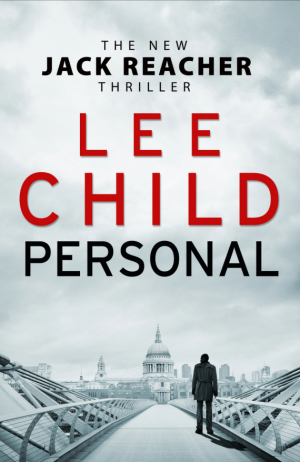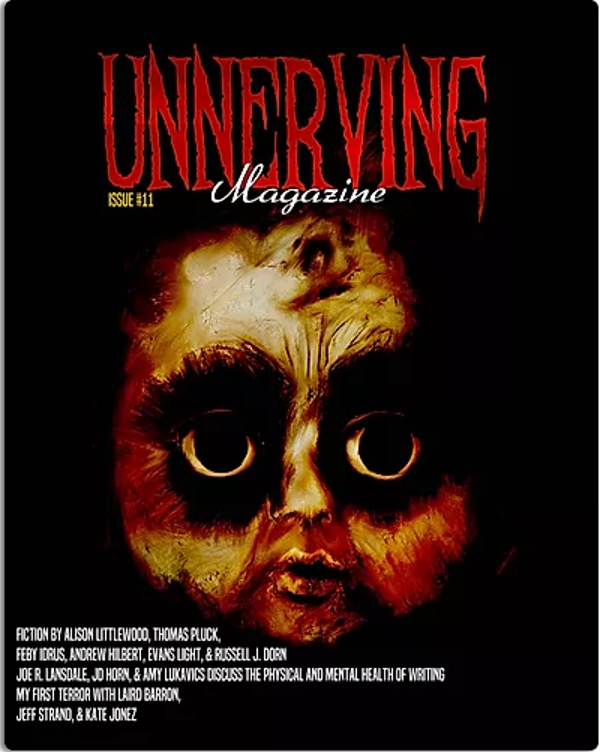
Today I’m gonna really push my limits—after all, this column is supposed to be about SF/F/H—and review the new Jack Reacher book by Lee Child. Said book, called Make Me, will make its debut on bookstore shelves (brick/mortar as well as virtual) on this coming Tuesday, September 8. If you’re anything like the rest of us slavering Reacher fans—and I’m guessing we’re mostly male—you’ll be standing at the register with $35 or so clutched in your trembling real or virtual hands! (I say “mostly male” because my dear wife, the Lovely and Talented Lynne Taylor Fahnestalk, never finished the JR hardcover I gave her to read. It just didn’t seem to grab her. Ever hopeful, I picked up another and, as soon as she’s finished the new Stephen King—Finders Keepers—she’ll give it another shot.)
I figure my editor will allow me a bit of slack because after all, we SF/F types are usually omnivorous readers, with a predilection for the mystery/detective/action genre, perhaps. That’s why Spider Robinson, for example, a pretty pure SF/F writer, is a fan of, and friends with Donald Westlake. That’s why, if you go down and look at the bookshelves lining practically every wall in our basement, you’ll find Westlake and several dozen other mystery/detective/action writers mixed in with the SF/F. (I’d love to find out what you, dear reader, like as your “break” from SF/F—is it mystery/tec/action? Is it Western? Is it gothic/romance? I’m interested in your non-SF/F fiction reading, so please leave me a comment on FB or here on Amazing Stories!)

The new Jack Reacher book, as I said, is called Make Me (it’s number 20!), and is typical Reacher. I’ll get to the specifics in a moment, so please bear with me. I would like to explore—if you folks will help—in a later column the difference between male readers of this kind of fiction and female readers, but I don’t have enough data. So let’s talk about “this kind of fiction” a bit, and why I read it.
Why I read it is probably pretty simple: a) I’m a male born in the late 1940s; and I really, really enjoy reading fiction about competent, intelligent people doing competent, intelligent things. When it comes to action, I’m “a guy.” I like guy stuff, like the literary equivalent of things blowing up. But I like puzzles and people solving them intelligently (that’s the detective part), and people who are at least a little bit larger than life. For me, Jack Reacher fits all those roles, because of how Lee Child constructed him.

Reacher is an ex-US Army cop, mustered out in 1997 with the rank of Major. (He’s always been called “Reacher,” by the way. Not even his own mother called him “Jack.”) He’s a big man—six feet five inches, and between 220-250 pounds; an imposing figure. If that isn’t impressive enough, he also received the Silver Star (for bravery), the Bronze Star, a Purple Heart and other awards that he describes as “junk medals” (like the Service ribbon that everyone gets). He grew up on Army bases around the world and now, since he’s “at large,” he spends his time traveling around the United States just seeing what’s there. Along the way he also gets into trouble—seldom his fault—and solves mysteries, mostly for self-protection. He doesn’t ask for trouble, but somehow trouble seems to find him. He carries no possessions or drivers’ license, just a folding toothbrush and an ATM card, usually. When his clothes get dirty he throws them away and buys new, cheap ones which he generally puts on immediately. He’s footloose and fancy free and goes where he wants, sees what he wants to see, and can take care of himself. The ideal loner. And although he seems to always do the right thing, he has human failings—in a previous book we find out he’s subject to claustrophobia (as I am sometimes), but manages to overcome it to survive. And in the new book, he suffers a major concussion, but manages nevertheless. Over all else, Reacher is a survivor.
A couple of years ago, Tom Cruise—who despite all the wackiness associated with his “religion”—and I use the quotes advisedly, because I think the whole Dianetics/Scientology thing was a scam thought up by L. Ron Hubbard (who reportedly told John W. Campbell, years ago, that if you wanted “to make real money, you should start your own religion”)—decided that he wanted to play Jack Reacher in a movie. And despite the fact that Cruise is about a foot shorter than Reacher, he reportedly set up a shell company to make a Jack Reacher book (One Shot, about a sniper shooting innocent people, and a man—not Reacher—wrongfully accused of the crime) into a movie called Jack Reacher, and hire himself as Reacher. So he did. Lee Child got a guest cameo in the movie, which also had Rosamund Pike, Werner Herzog and Robert Duvall. It wasn’t bad, despite the cognitive dissonance engendered by having Cruise in the title role. Part of its success was probably because Lee Child helped write the script. (Cruise is now engaged in filming the second Reacher movie, based on the book Never Go Back, in which Reacher is accused by the Army of a murder he didn’t commit.) Child himself is okay with Cruise as Reacher, calling Cruise one of the great actors of our time. Well, he’s a damned good actor, but I think maybe Child is overstating it.

I think I first encountered Reacher about five or six years ago; can’t remember which book; now, of course, I’ve read every Reacher novel and most of the short stories. I guess to some extent he’s the modern Huck Finn; instead of just lazing down the ol’ Mississippi on a raft, he’s taking the bus or the train from nowhere to nowhere, hooking up with the occasional woman, usually as they work to solve a crime together (often one Reacher is wrongly accused of). For a guy, what’s not to like? What kinds of things does Reacher get involved in? As I said, he’s often the fall guy when he moves into a town on his restless quest; the stranger with no roots is a convenient target in a small town with a secret. Sometimes he’s mistaken for someone else, and drawn willy-nilly into a mystery, as is the case with the newest book.
Capsule review, no spoilers of Make Me: Near a small Midwestern town surrounded by miles and miles of wheat fields, a backhoe is fired up around midnight; assuming that nobody will see them, a couple of men are burying the body of a large man under a pigpen. But on a train passing through (I believe it’s in Kansas—it’s never actually stated, but internal clues—Oklahoma City is 5 hours south, I-25 and Colorado Springs are many hours west—say so) at midnight, Reacher notices the backhoe’s lights, then sees a town called “Mother’s Rest,” and decides to get off and find out why the town is called that. He imagines a wagon train in the Old West, where either a young woman had a baby, or an old woman dies; he’s sure there will be a monument, or perhaps a small museum commemorating the event. At any rate, his interest is piqued, and he has nothing else to do, so he gets off the train. He is met at the closed station by a young Asian woman, who has obviously mistaken him for someone else. He walks into town and takes a room at the only motel in town; mostly deserted except for a few rooms in use. He has to talk the clerk down from $60 to $25; afterwards, the clerk takes a plastic chair and sits down to watch Reacher’s room (and the Asian woman’s room at the same time).

In the morning, Reacher has breakfast at the only cafe in town, and talks to the Asian woman, whose name is Michelle Chang. She is a private investigator, ex-FBI, who has come to town looking for another agent of the firm she works for, Keever, who had called her in on a “private” case; however, Keever has disappeared. Reacher leaves her to it, and quarters the town on foot, looking for a monument, a memorial or a museum to the Mother’s Rest person, but finds nothing. His (and Chang’s) every move is watched by someone; phone calls go from various spots around town to a mysterious number. The watchers figure (wrongly) that Reacher is searching the town for Keever. The mystery deepens, especially after Reacher and Chang, riding together in her rented car—he figures he might as well help her with her disappearing partner, having not much else to do—are braced by a pair of locals in a pickup and told to leave town. If you’ve seen the movie Jack Reacher, you can probably figure out how well that worked out for them (the locals). Reacher now knows—since there was no obvious reason for the locals to threaten him and Chang—that there’s something wrong, something hidden, in this little town in the middle of nowhere.
The rest of the book develops well; Reacher finds out that Chang doesn’t know who Keever’s client was; they investigate Keever’s house in Oklahoma City but find no clues either to his disappearance or to his client; eventually they find one clue that leads them to an investigative newspaper reporter for the LA Times in Los Angeles, where an attempt is made on their lives. Carefully following clues, and pushing the locals as much as possible, Reacher and Chang eventually close in on the source of the mystery, though they have to make trips to LA, San Francisco and Oklahoma City, among other places.
Parts of the book are somewhat predictable, given that this is the twentieth book in a series; by now we have a pretty good idea of how Reacher will react to most scenarios. The town’s secret is eventually revealed, and it’s an horrific one, possibly the worst Reacher has encountered. Normally, I’m not affected by things that happen in fiction, but this one got to me somewhat; I have a feeling that many readers will be discomfited by the revelation. But I felt somewhat dissatisfied with this book, and after rereading it a couple of times I think I know what it is: even though Reacher has—and this is not really a spoiler—a major concussion, it doesn’t affect the storyline or the outcome. As a result, I have to ask “why even put it in?” The only answer I can come up with is that it might be important to another, upcoming book. Otherwise, it’s a flaw in an otherwise very readable series. I’ll give Make Me a qualified “thumbs-up” as a reader. (And I have no idea how the title relates to the book, either. If you go to Lee Child’s website you will find a discussion about titles, but nothing about this one.)

As a side note—marketing, if you will—I find it interesting to note that the US covers appear (with the exception of the Tom Cruise movie tie-in) to have mostly geometrical graphics, or generic illustrations, with no human being—probably allowing the reader to form his/her own mental picture of Reacher (see Figure 5). The more recent UK covers (see Figure 6) show—always from the back, you will note) a large, male figure in a setting (usually from the book) which, I think, still allows readers to form their own mental images. (And for those keeping track, you’ll note that the bridge featured in Figure 6—which appears to be the Millennium Bridge in London—was destroyed by Dementors in Harry Potter and the Order of the Phoenix! I found that interesting.)
Just a thought–witness Bruce Willis in Unbreakable (with Samuel Jackson), a film by M. Night Shyamalan, in which an ordinary guy, a security guard at a football stadium, finds out he apparently has “superhuman” strength and has never been ill or injured. Could Jack Reacher be another superhero in “ordinary man” guise? So maybe these are genre books after all; maybe that’s what Lee Child is working up to. (Nah, probably not. But fun to speculate, eh?)
If you can, please comment on this week’s column/blog entry. If you haven’t already registered—it’s free, and just takes a moment—go ahead and register/comment here; or comment on my Facebook page, or in the several Facebook groups where I publish a link to this column. I might not agree with your comments, but they’re all welcome, and don’t feel you have to agree with me to post a comment; my opinion is, as always, my own, and doesn’t necessarily reflect the views of Amazing Stories or its owners, editors, publishers or other bloggers. See you next week!











Recent Comments